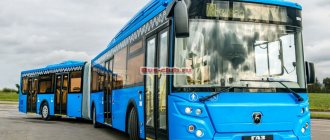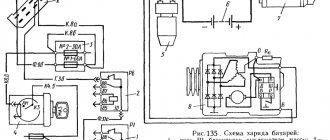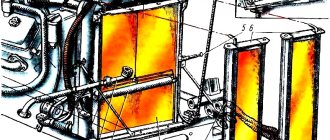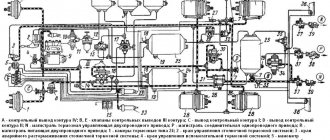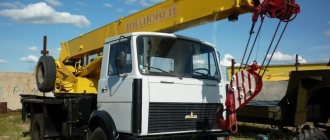| MAZ-226 | |
| K:Wikipedia:Articles without images (type: not specified) | |
| Manufacturing plant | MAZ |
| Project, g | 2006 |
| Produced, years | 2007- n.d. |
| Gross weight, t | 12000 kg |
| Max. speed, km/h | 98-105 km/h |
| ECO standard | Euro 3 |
| Capacity, persons | |
| Seating | 31 |
| Nominal capacity (5 people/m²) | 59 |
| Dimensions | |
| Base, mm | 4170 mm |
| Salon | |
| Number of doors for passengers | 2 |
| Door formula | 1+1 1 |
| Engine | |
| Engine model | Mercedes-Benz OM 904LA |
| Fuel type | Diesel |
| Power, hp | 177 hp |
| Transmission | |
| Gearbox model | ZF |
| Gearbox type | Mechanical, automatic/ |
MAZ-226
- a semi-low-floor commuter bus of the Minsk Automobile Plant, created on the basis of the MAZ-206.
Cabin interior
The cabin has 2 doors for passengers to enter and exit. In addition, there is a storage area in front of the central door. Due to the absence of a rear door, the company was able to increase the passenger capacity of the car.
The MAZ-226 two-door bus is equipped with 31 seats for passengers. At the same time, the maximum number of people that can be transported reaches 59. Due to tinted glass, a cool microclimate is ensured in the cabin during the warm season. Window tinting also prevents the interior decoration from fading in the sun.
The interior is equipped with handrails, to which additional hinges are attached. This reduces the potential risk of injury to passengers while driving or stopping suddenly.
The manufacturer has provided the ability to adjust the steering column and adjust the driver's seat.
An excerpt characterizing the MAZ-226
Who thinks about you too! That she too, with her beautiful hand, wandering along the golden harp, with her passionate harmony, calls to her, calls you! Another day or two, and heaven will come... But ah! your friend won't live! And he had not yet finished singing the last words when the young people in the hall were preparing to dance and the musicians in the choir began to knock their feet and cough. Pierre was sitting in the living room, where Shinshin, as if with a visitor from abroad, began a political conversation with him that was boring for Pierre, to which others joined. When the music started playing, Natasha entered the living room and, going straight to Pierre, laughing and blushing, said: “Mom told me to ask you to dance.” “I’m afraid of confusing the figures,” said Pierre, “but if you want to be my teacher...” And he extended his thick hand, lowering it low, to the thin girl. While the couples were settling down and the musicians were lining up, Pierre sat down with his little lady. Natasha was completely happy; she danced with a big one, with someone who came from abroad. She sat in front of everyone and talked to him like a big girl. She had a fan in her hand, which one young lady had given her to hold. And, assuming the most secular pose (God knows where and when she learned this), she, fanning herself and smiling through the fan, spoke to her gentleman. - What is it, what is it? Look, look,” said the old countess, passing through the hall and pointing at Natasha. Natasha blushed and laughed. - Well, what about you, mom? Well, what kind of hunt are you looking for? What's surprising here? In the middle of the third eco-session, the chairs in the living room, where the count and Marya Dmitrievna were playing, began to move, and most of the honored guests and old people, stretching after a long sitting and putting wallets and purses in their pockets, walked out the doors of the hall. Marya Dmitrievna walked ahead with the count - both with cheerful faces. The Count, with playful politeness, like a ballet, offered his rounded hand to Marya Dmitrievna. He straightened up, and his face lit up with a particularly brave, sly smile, and as soon as the last figure of the ecosaise was danced, he clapped his hands to the musicians and shouted to the choir, addressing the first violin:
Specifications
| Engine model | Mercedes-Benz OM 904 LA |
| Volume | 4.3 l |
| Number of cylinders | 4 |
| Environmental class | Euro 5 |
| Maximum power | 177 hp |
| Wheel formula | 4×2 |
| Maximum speed | 104 km/h |
| Full mass | 12.6 tons |
| Suspension | Dependent, pneumatic |
The bus is equipped with a 4-cylinder turbocharged diesel power unit of the Mercedes-Benz OM904 LA brand with a volume of 4.3 liters and a power of 177 hp. Previously, this engine was produced in accordance with Euro-4 standards, and today, new MAZ-226 buses are equipped with a Mercedes-Benz OM904 LA engine, which already complies with Euro-5 standards. The power unit works in conjunction with a 6-speed manual or automatic transmission.
A modification of the MAZ-226063 is also available, which is equipped with a Mercedes-Benz OM924LA (E-5) power unit with a volume of 4.8 liters, which works in conjunction with a 6-speed manual transmission ZF 6S1010 BO. This engine can provide power equal to 218 hp.
Both the engine and gearbox are manufactured by German manufacturers, which increases reliability. In addition to the ZF gearbox, the bus can also be equipped with Allison and Voith Diwa transmissions.
The power units used allow you to reach a speed of 105 km/h. The machine is equipped with a fuel tank with a capacity of 140 liters.
Destroying stereotypesBus MAZ-226067
In 2006, at the Moscow International Motor Show, the second-generation medium city bus MAZ-206 was shown to the public, and I heard a lot of skeptical reviews about the fate of the then prototype. Few people believed that the Minsk model would go into production. The main argument of the pessimists was the fact that the costs of producing a middle-class “low-floor aircraft” are comparable to the costs of creating a full-size airliner. This means that the price of the new product will be slightly lower than the price of a regular city bus. Will the middle-class model be able to find its buyer in this case, if there are many passenger cars on the market with the same capacity, but created using cheaper technology - based on conventional front-engine trucks?Apparently, no problems are expected with orders. The model range is expanding and a commuter version of the MAZ-226 bus has been presented to the public - another proof of this. How can the average “low country resident,” and in particular the suburban “Minsk resident,” attract consumers? We’ll talk about this today. The appearance of the new product, or rather the entire second generation of MAZ buses, deserves special attention. In press releases, the factory workers call it modern design, but I would say more. Perhaps for the first time in the post-Soviet space, a concept for a whole generation of passenger cars has been developed, which is equally close to the MAZ-251 tourist airliner, large and medium-sized city models and “hybrids” like the MAZ-256. Even the platform MAZ-171 has much in common with the second generation of Belarusian buses. In such diverse examples of technology, one can unmistakably recognize the pedigree, feel the “breed”. This is not some run-down American bison, but a real Belarusian bison! And the most gratifying thing is that not a single skeptic can accuse the designers of plagiarism. The contours and connecting lines are truly original and organically balanced. Pointed front and rear optics create a complete, recognizable and... (we agree with the factory workers) modern image. In general, we can give AMAZ designers a ten plus for creating a unique look! According to the five-point system! Two short, one with a boom. Hooray! Hooray! Hooray! But let's move on from romance to pressing matters. According to the designers, medium-sized “low-floor” vehicles are designed for a wide range of applications – both for passenger transportation in small cities and for moderately loaded routes in megacities. A suburban modification, in addition to its main purpose, may also be attractive as a departmental, official transport. MAZ-226 has an increased (compared to the 206) number of seats - 31 luxury seats. Naturally, the total passenger capacity decreased from 72 to 59 people. The bus has two pantograph doors and spacious storage areas. To speed up passenger exchange, the floor from the road surface is at the level of 340 mm. And if the bus “sits down” (modern “low-floor buses” are unthinkable without kneading), the height will be only 270 mm, which will significantly facilitate entry and exit for the elderly and people with disabilities. For passengers with musculoskeletal disorders, the bus is standardly equipped with a folding ramp. Slightly curved comfortable handrails with complex geometry also became the hallmark of the second generation of Belarusian city airliners. I think passengers will like them. The driver’s workplace is a different matter. And one more stone for the pessimists. At the first display, the instrument panel, as if suspended in the air and moved from the windshield to the driver, was perceived by literally everyone as a flight of fancy from the designers. They say, it’s beautiful, of course, but mass production of such panels is unrealistic. The rigid limits of mass production also clipped the wings of richer manufacturers. But AMAZ surprised everyone here too. To date, six medium low-floor buses have been produced, and all of them are equipped with a new rounded instrument cluster with driver-facing air deflectors and an electronic display displaying statistical information. It looks beautiful and is convenient in practice. The driver has complete freedom: a wide range of seat and steering column adjustments allows you to show your imagination. Interestingly, the driver's seat on the tested bus is not separated from the passenger compartment by a partition, which contradicts the requirements of the standards of most CIS countries. This suggests that the bus is aimed at export, since in Europe the so-called unity of passengers and driver is only welcome. The suburban version, like the city version, is equipped with a Mercedes-Benz OM 904 LA power unit that meets Euro 3 environmental requirements and develops maximum power 130 kW (176 hp). Engine volume – 4250 cm3. But the maximum speed for a commuter bus was increased from 88 to 105 km/h. The Minsk Automobile Plant quite reasonably expects interest from European carriers, so the MAZ-226 is also equipped with a Euro 4 engine. The bus is equipped with a ZF manual transmission, but at the buyer’s request, it is also possible to install an automatic transmission from the same company. Separately, it can be noted that the front and drive axles have an original design, developed in Minsk. This will probably facilitate maintenance and search for spare parts, since all components for these units will be produced at the factory. MAZ-226 is equipped with dependent air suspension; There are two air cylinders installed in front, and four in the rear. Therefore, there are no complaints about the smooth ride of the commuter bus. Even in sharp turns the car behaves confidently. The low center of gravity played a significant role here. The braking system is also pneumatic, with electronically controlled ABS and ASR systems; It is also possible to install an EBS stabilization system. Disc brakes are used on all wheels. Integral steering provides excellent maneuverability. Judge for yourself: the outer turning radius of an almost 9-meter car is 9.5 m. Sitting behind the wheel of a MAZ-226, you feel like the driver of a full-fledged bus, maneuvering it is a pleasure. It seems to be created for the central part of old European cities with narrow streets and dense buildings. Thanks to the overall short length and short front overhang, it seems that the bus will go anywhere. To increase strength, the frame of the MAZ-226 is made according to the frame principle (widely used in shipbuilding, where lightness and maximum structural strength are important). And this has a positive effect on the passive safety of the car. In the suburban version, storage compartments are provided outside (on the left side), but since the bus is low-floor, they cannot be called voluminous. The luggage compartment capacity is only 0.4 m3. Such a space can easily be filled by any grandmother bringing gifts to her grandchildren in the city. What should other grandmothers do? On the starboard side, in front of the middle door, two batteries were placed on retractable platforms, which makes their maintenance easy. The cooling radiator was installed in the rear overhang behind the right wheel. At the time of the test, only six medium low-floor buses were produced. But in one day we managed to see three of them on the streets of Minsk. We tested one, the second we just drove by, the third we accidentally met at one of the open exhibitions in the city. This suggests that the cars are already in demand and people are interested in them. The marketers of the Minsk Automobile Plant were not mistaken. Low operating costs, imported components, plus decent build quality attracted the interest of potential buyers. So, all that’s left to do is to launch mass production. And there will be no problems with orders. Technical characteristics of the MAZ-226067 commuter bus
Gross weight, kg 12,600 Permissible load on the front axle, kg 4300 Permissible load on the rear axle, kg 8300 Passenger capacity (seats) 59 (31) Luggage compartment volume, m3 0.4 Outer turning radius, m 9.5 Floor height on the middle door platform ( with kniling), mm 340 (270)Mercedes-Benz OM 904 LA engineEngine displacement, cm3 4250Common Rail power systemMaximum speed, km/h 105Tire size 245/70 R19.5Front/rear suspension Dependent pneumaticBrake system Pneumatic
Suspension and brakes
The MAZ-226 bus is equipped with both front and rear air suspension. In this case, the front suspension is independent. According to experts, the presence of an independent air suspension ensures a smooth ride.
The car is equipped with a pneumatic brake system with drum mechanisms installed on all wheels. The brake mechanisms are controlled using modern electronics. To increase safety, the machine is equipped with additional systems: ABS and ASR.
The steering design also includes a hydraulic booster, which allows the driver to be less tired during the trip.
The bus has a monocoque body. In this case, the body frame consists of box-shaped profiles, covered on top and sides with galvanized steel panels. Due to modern materials, the body resists corrosion processes well. This significantly increases the useful life of the machine.
Peculiarities
The semi-low-floor bus was created on the platform of the MAZ-206 model. The driving axle of this car is the rear axle. The model with a 4x2 wheel arrangement belongs to the middle class.
Today, several modifications of the machine are produced, which differ in engines, gearboxes, as well as other components and assemblies.
Peculiarities:
- Modern German engines provide fuel efficiency;
- The presence of a luggage compartment allows you to use the car for intercity transportation;
- The bus has good maneuverability and smooth ride.
The presence of a large number of foreign components and assemblies in the design of the machine can lead to an increase in operating costs, as well as repair costs, with a sharp change in the exchange rates of the dollar and euro against the Russian ruble.
